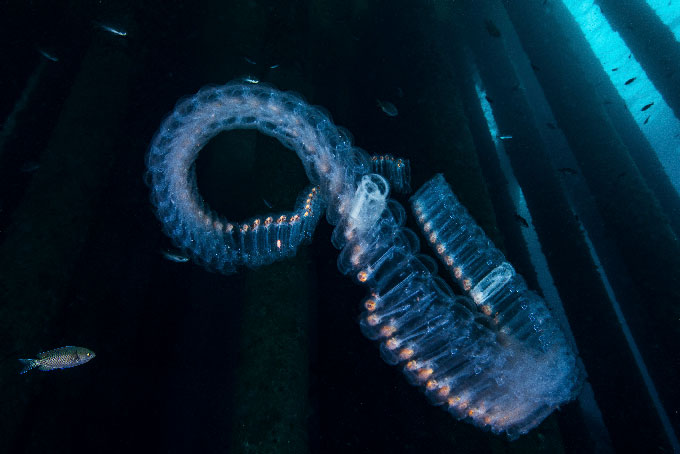How Far the Light Reaches
Sabrina Imbler
Little, Brown & Co., $27
In How Far the Light Reaches, Sabrina Imbler shows us that the ocean, in all its mystery and dazzling glory, is queer — that is, the life that takes shape there challenges how we landlubbers perceive ways of being. This collection of essays tells the stories of 10 sea creatures, with Imbler, a queer and mixed-race writer, weaving in stories of their own family, self-discovery, sexuality and healing. The profiled animals, often thought of as strange or alien, transform into recognizable emblems of identity, community and queer joy in this delectable amalgam of memoir and science journalism.
Imbler begins with a confession: “The truth is that I was asked to leave the Petco, but I told everyone I was banned.” Thirteen-year-old Imbler had staged a protest in the store, attempting to convince customers not to buy goldfish bowls. The bowls, Imbler writes, condemn the fish to a truncated life in a transparent coffin, in which they will die isolated, starved of oxygen and poisoned with ammonia from their own urine.
But unencumbered by the confines of a bowl, the fish thrive. When bored pet owners dump goldfish in lakes or rivers, the fish can balloon to the size of jugs of milk. They are “so good at living they have become an ecological menace,” breeding with abandon, uprooting bottom dwellers, and fomenting bacterial growth and algal blooms, Imbler writes.
Yet Imbler can’t help but admire the feral goldfish’s resilience: “I see something that no one expected to live not just alive but impossibly flourishing.”
Survival among unthinkable circumstances is a theme common to all the profiled animals. Take the yeti crab (Kiwa puravida), which, after reading this book, I now proclaim a queer icon (step aside, the Babadook). In the frigid dark, about 1,000 meters below the sea surface, the crab finds solace near hydrothermal vents.
Such hot spots foster life in a desolate wasteland. Heat and chemicals from inside the Earth sustain an ecosystem of crabs, clams, mussels, tube worms and more. There, in true queer fashion, K. puravida “dances to live,” Imbler writes. The yeti crab throws its claws in the air and waves ’em like it just don’t care. In doing so, it is “farming” the bacteria that it eats, which cling to the crab’s bristly claws. Waving the claws in a slow but steady rhythm ensures the bacteria get nutrients.
In telling the crab’s story, Imbler reminisces on their quest to find community after moving to Seattle in 2016. Feeling alone among the mostly white people they met, Imbler discovered a monthly party called Night Crush, thrown by and for queer people of color. Night Crush became Imbler’s own hydrothermal vent — an oasis warmed by people dancing in mesh, sequins, glitter and joy. “As queer people, we get to choose our families,” Imbler writes. “Vent bacteria, tube worms, and yeti crabs just take it one step further. They choose what nourishes them.”
Subscribe to Science News
Get great science journalism, from the most trusted source, delivered to your doorstep.
Imbler looks to the sea to explore all aspects of family. The purple octopus (Graneledone boreopacifica), for instance, offers insights on motherhood. During a four-and-a-half-year brooding period, the longest known for any animal, the octopus starves herself to death, foregoing hunting to protect her eggs (SN: 7/30/14).
Through the octopus’ saga, Imbler reflects on their own mother, who moved to the United States from Taiwan as a child. Imbler’s mother felt like she was on “a new planet.” To survive, she learned to want to be as white and “American” as possible, and as thin as possible — traumas inherited by Imbler, who developed an eating disorder.
In their recovery, Imbler has realized their mother’s wish for them to be thin, though damaging, was, in a way, an act of love: “She wanted me to be skinny so things would be easier. White, so things would be easier. Straight, so things would be easy, easy, easy. So that unlike her, no one would ever question my right to be here, in America.”

It is with that same grace, clarity and tenderness that Imbler crafts the book’s other essays, whether it’s meditating on their own gender expression through the cuttlefish’s mastery of metamorphosis or examining their experience of sexual assault through the sand striker, an ambush predator of the seafloor.
Like a goldfish confined by a bowl, I am confined by my word count and can’t say everything I want to about this must-read book. So I’ll end on one final insight. In one essay, Imbler introduces salps. These jelly-like blobs exist as a colony of hundreds of identical salps joined in a chain. The creatures do not move in one synchronized effort. “Salps allow each individual to jet at its own pace in the same general direction,” Imbler writes. “It is not as fast as coordinated strokes, but it’s more sustainable long-term, each individual sucking and spurting as it pleases.”
This idea of one collective, made up of individuals marching toward a common cause at their own pace, is one that queer people and other marginalized groups know well — whether creating community or protesting for civil rights. And it’s a notion that Imbler imparts upon their reader: “We may all move at different paces, but we will only reach the horizon together.”
Buy How Far the Light Reaches from Bookshop.org. Science News is a Bookshop.org affiliate and will earn a commission on purchases made from links in this article.

